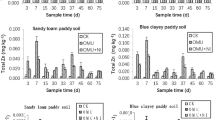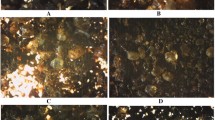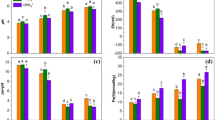Abstract
Laboratory incubation study showed that iron pyrites retarded nitrification of urea-derived ammonium (NH4 +), the effect being greatest at the highest level (10000 mg kg–1 soil). Nitrification inhibition with 10000 mg pyrite kg–1 soil, at the end of 30 days, was 40.3% compared to 55.9% for dicyandiamide (DCD). The inhibitory effect with lower rates of pyrite (100–500 mg kg–1) lasted only up to 9 days. Urea+pyrite treatment was also found to have higher exchangeable NH4 +-N compared to urea alone. DCD-amended soils had the highest NH4 +-N content throughout. Pyrite-treated soils had about 7–86% lower ammonia volatilization losses than urea alone. Total NH3 loss was the most with urea+DCD (7.9% of applied N), about 9% more than with urea alone.
Similar content being viewed by others
Author information
Authors and Affiliations
Additional information
Received: 11 November 1995
Rights and permissions
About this article
Cite this article
Blaise, D., Amberger, A. & von Tucher, S. Influence of iron pyrites and dicyandiamide on nitrification and ammonia volatilization from urea applied to loess brown earths (luvisols). Biol Fertil Soils 24, 179–182 (1997). https://doi.org/10.1007/s003740050228
Issue Date:
DOI: https://doi.org/10.1007/s003740050228




